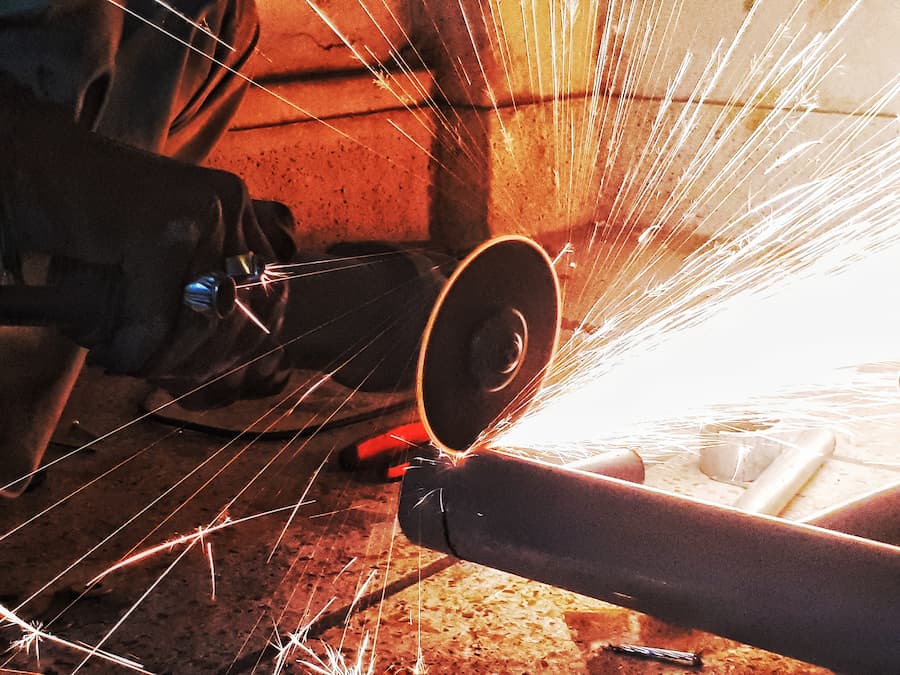How to stay safe when grinding

A razor sharp wheel spinning at 6500 RPM is never going to be a 100% safe tool to be around.
However, there’s plenty that you can do to stay safe on site when using a grinder.
Large 9” angle grinders have serious power, and safety and PPE procedures should be closely followed to avoid injury when using them. Even smaller 5” grinders are cause for concern if they are not used properly.
In particular, taking safety shortcuts is a bad idea: removing guards, using bigger wheels than the tool is designed for, or not using the proper tools to secure the wheels can all cause safety hazards.
Read on to see how to work more safely with your angle grinder.
Reducing hazards when using an angle grinder
As always, it’s best to follow the hierarchy of workplace hazard controls to try and engineer out hazards. This means you could potentially change your work processes or use administrative controls before resorting to using safety gear.
Angle grinders can present hazards such as sudden kickbacks, impact hazards from shattered wheels, as well as serious cuts and lacerations. Bystanders can be put at risk too, if the person grinding hasn’t allowed for a wide safety zone around the area.
Making sure that you do not use a grinder that is overpowered for the job is important. Additionally, ensure that the type of disc used is suitable for the task. The wrong disc could shatter or ‘grab’ the item you’re working on, causing kickback and therefore injury.
Furthermore, the guards must never be removed. They’re there for a reason! Guards should be positioned so they cover half of the disc area and sit between the disc and the operator.
Things to check before you start
- Ensure operators are properly trained.
- Choose an angle grinder that has an automatic cut-off or dead-man switch as part of the handgrip. This is designed to cut off power as soon as finger pressure is released.
- Make sure there are no defects, cracks or damage to the disc, and ensure the type of disc is appropriate for the material being cut or ground.
- Ensure the correct flange and locking nut is in place for the type of disc being used, otherwise the disc can shatter at high speed
- Only use the tightening tool supplied by the manufacturer to tighten the disc - other methods can damage both the disc and grinder
- Check the guard and handles are secure
- Check you’re using the correct disc diameter and central disc hole size
Finally – use a quality grinder from a reputable brand, such as the Milwaukee M18 FUEL 9” Angle Grinder.
Recommended PPE for grinding
Your state workplace safety authority can provide more detailed information, however generally, the following PPE will help to protect you on the job. Note you should always check with your workplace health and safety officer regarding what is required for your individual situation.
- Protect your eyes and face: wide vision goggles or medium impact safety glasses should be used at a minimum. For 9” angle grinders a face shield combined with goggles or glasses can provide high impact protection.
- Protect your ears: ear muffs or ear plugs will lessen the volume. Class 5 hearing protection is ideal, although the choice of grinding or cutting disc, as well as the type of material the grinder is being used on, will affect the decibel rating.
- Safety boots with steel toecaps are a must, as well as properly fitted clothing without loose or dangling parts that could be caught in the grinder.
- Additionally, comfortable work gloves will provide good grip and help prevent dropping or losing control of the grinder. Gloves that provide excellent dexterity and cut resistance such as a cut 5 rated glove are a good choice.
Further information:
WorkSafe QLD - guards and discs on angle grinders
Safe Work SA - angle grinders
Shop for power tools and hardware online
Jaybro has a great range of all your favourite brands of power tools including Milwaukee, Makita, Boshc, DeWalt and more. Take a look at our range of power tools for sale or call our friendly team for advice and pricing.
 Sign In
Sign In 

